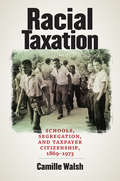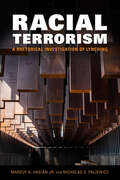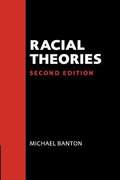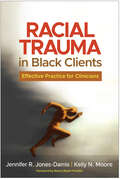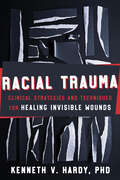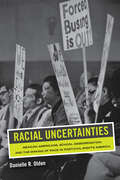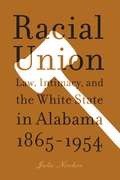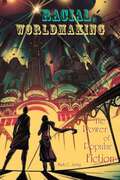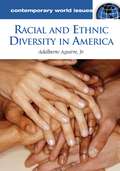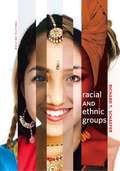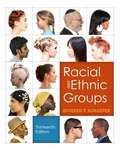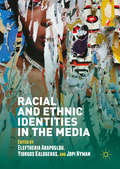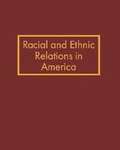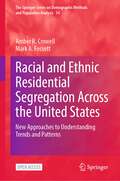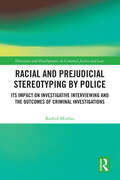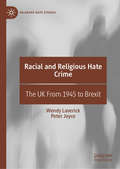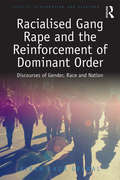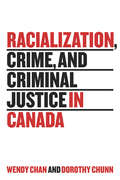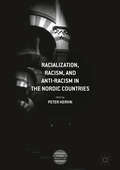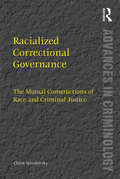- Table View
- List View
Racial Taxation: Schools, Segregation, and Taxpayer Citizenship, 1869–1973 (Justice, Power, and Politics)
by Camille WalshIn the United States, it is quite common to lay claim to the benefits of society by appealing to "taxpayer citizenship--the idea that, as taxpayers, we deserve access to certain social services like a public education. Tracing the genealogy of this concept, Camille Walsh shows how tax policy and taxpayer identity were built on the foundations of white supremacy and intertwined with ideas of whiteness. From the origins of unequal public school funding after the Civil War through school desegregation cases from Brown v. Board of Education to San Antonio v. Rodriguez in the 1970s, this study spans over a century of racial injustice, dramatic courtroom clashes, and white supremacist backlash to collective justice claims.Incorporating letters from everyday individuals as well as the private notes of Supreme Court justices as they deliberated, Walsh reveals how the idea of a "taxpayer" identity contributed to the contemporary crises of public education, racial disparity, and income inequality.
Racial Terrorism: A Rhetorical Investigation of Lynching (Race, Rhetoric, and Media Series)
by Marouf A. Hasian Jr. Nicholas S. PaliewiczIn December 2018, the United States Senate unanimously passed the nation’s first antilynching act, the Justice for Victims of Lynching Act. For the first time in US history, legislators, representing the American people, classified lynching as a federal hate crime. While lynching histories and memories have received attention among communication scholars and some interdisciplinary studies of traditional civil rights memorials exist, contemporary studies often fail to examine the politicized nature of the spaces. This volume represents the first investigation of the National Memorial for Peace and Justice and the Legacy Museum, both of which strategically make clear the various links between America’s history of racial terror and contemporary mass incarceration conditions, the mistreatment of juveniles, and capital punishment. Racial Terrorism: A Rhetorical Investigation of Lynching focuses on several key social agents and organizations that played vital roles in the public and legal consciousness raising that finally led to the passage of the act. Marouf A. Hasian Jr. and Nicholas S. Paliewicz argue that the advocacy of attorney Bryan Stevenson, the work of the Equal Justice Initiative (EJI), and the efforts of curators at Montgomery’s new Legacy Museum all contributed to the formation of a rhetorical culture that set the stage at last for this hallmark lynching legislation. The authors examine how the EJI uses spaces of remembrance to confront audiences with race-conscious messages and measure to what extent those messages are successful.
Racial Theories
by Michael BantonThis thoroughly revised and updated edition of Michael Banton's classic book reviews historical theories of racial and ethnic relations and contemporary struggles to supersede them. It shows how eighteenth- and nineteenth-century concepts of race attempted to explain human difference in terms of race as a permanent type and how these were followed by social scientific conceptions of race as a form of status. In a new concluding chapter, 'Race as social construct', Michael Banton makes the case for a historically sensitive social scientific understanding of racial and ethnic groupings which operates within a more general theory of collective action and is, therefore, able to replace racial explanations as effectively as they have been replaced in biological science. This book is essential reading for anyone wanting to understand contemporary debates about racial and ethnic conflict.
Racial Transformations: Latinos and Asians Remaking the United States
by Nicholas De GenovaMoving beyond the black-white binary that has long framed racial discourse in the United States, the contributors to this collection examine how the experiences of Latinos and Asians intersect in the formation of the U. S. nation-state. They analyze the political and social processes that have racialized Latinos and Asians while highlighting the productive ways that these communities challenge and transform the identities imposed on them. Each essay addresses the sociopolitical predicaments of both Latinos and Asians, bringing their experiences to light in relation to one another. Several contributors illuminate ways that Latinos and Asians were historically racialized: by U. S. occupiers of Puerto Rico and the Philippines at the end of the nineteenth century, by public health discourses and practices in early-twentieth-century Los Angeles, by anthropologists collecting physical data--height, weight, head measurements--from Chinese Americans to show how the American environment affected "foreign" body types in the 1930s, and by Los Angeles public officials seeking to explain the alleged criminal propensities of Mexican American youth during the 1940s. Other contributors focus on the coalitions and tensions between Latinos and Asians in the context of the fight to integrate public schools and debates over political redistricting. One addresses masculinity, race, and U. S. imperialism in the literary works of Junot Daz and Chang-rae Lee. Another looks at the passions, identifications, and charges of betrayal aroused by the sensationalized cases of Elin Gonzlez, the young Cuban boy rescued off the shore of Florida, and Wen Ho Lee, the Los Alamos physicist accused of spying on the United States. Throughout this volume contributors interrogate many of the assumptions that underlie American and ethnic studies even as they signal the need for a research agenda that expands the purview of both fields. Contributors. Nicholas De Genova, Victor Jew, Andrea Levine, Natalia Molina, Gary Y. Okihiro, Crystal Parikh, Greg Robinson, Toni Robinson, Leland T. Saito
Racial Trauma in Black Clients: Effective Practice for Clinicians
by Jennifer R. Jones-Damis Kelly N. MooreUnderstanding and addressing the impact of racial trauma is vital for providing culturally responsive, trauma-informed care. This book explores how racial stressors affect all aspects of Black clients' lives and offers powerful ways to support healing. Therapists and counselors will gain tools for approaching--rather than avoiding--the topic of race in individual therapy and in family, school, and community contexts. The book discusses how to incorporate aspects of racial trauma into assessment and case conceptualization; validate clients' pain as well as their strengths; and adapt evidence-based treatments to overcome cultural gaps. It presents extensive case examples; dos and don'ts; and self-care strategies for therapists of any background. Instructive features include end-of-chapter takeaway points, bolded key terms, and an end-of-book glossary.
Racial Trauma: Clinical Strategies and Techniques for Healing Invisible Wounds
by Kenneth V. HardyAn urgent, wide-ranging account of racial trauma and its psychological impact. Racial trauma is an inescapable byproduct of persistent exposure to repressive circumstances that emotionally, psychologically, and physically devastates one’s sense of self while simultaneously depleting one’s strategies for coping. It is a life-altering and debilitating experience that affects countless numbers of people of color over multiple generations. Unfortunately, the failure to consider the interrelationship between racial oppression and trauma limits clinicians’ ability to work effectively with many people of color who live amid sociocultural conditions that are injurious to their psyches and souls. Even when therapy is trauma-informed, it rarely devotes adequate attention to racial oppression and the pervasive trauma associated with it. This groundbreaking book provides a comprehensive overview of the anatomy of racial trauma and the debilitating hidden wounds associated with it. Racially sensitive trauma-informed interventions and strategies that centralize race and racial oppression in every facet of the therapeutic process and relationship are meticulously highlighted, making this a must-read resource for all practicing and aspiring clinicians.
Racial Uncertainties: Mexican Americans, School Desegregation, and the Making of Race in Post–Civil Rights America (American Crossroads #68)
by Danielle R. OldenMexican American racial uncertainty has long been a defining feature of US racial understanding. Were Mexican Americans white or nonwhite? In the post–civil rights period, this racial uncertainty took on new meaning as the courts, the federal bureaucracy, local school officials, parents, and community activists sought to turn Mexican American racial identity to their own benefit. This is the first book that examines the pivotal 1973 Keyes v. Denver School District No. 1 Supreme Court ruling, and how debates over Mexican Americans' racial position helped reinforce the emerging tropes of colorblind racial ideology. In the post–civil rights era, when overt racism was no longer socially acceptable, anti-integration voices utilized the indeterminacy of Mexican American racial identity to frame their opposition to school desegregation. That some Mexican Americans adopted these tropes only reinforced the strength of colorblindness in battles against civil rights in the 1970s.
Racial Union: Law, Intimacy, and the White State in Alabama, 1865-1954
by Julie NovkovIn November 2001, the state of Alabama opened a referendum on its long-standing constitutional prohibition against interracial marriage. A bill on the state ballot offered the opportunity to relegate the state's antimiscegenation law to the dustbin of history. The measure passed, but the margin was alarmingly slim: more than half a million voters, 40 percent of those who went to the polls, voted to retain a racist and constitutionally untenable law. Julie Novkov's Racial Union explains how and why, nearly forty years after the height of the civil rights movement, Alabama struggled to repeal its prohibition against interracial marriage---the last state in the Union to do so. Novkov's compelling history of Alabama's battle over miscegenation shows how the fight shaped the meanings of race and state over ninety years. Novkov's work tells us much about the sometimes parallel, sometimes convergent evolution of our concepts of race and state in the nation as a whole.
Racial Worldmaking: The Power of Popular Fiction
by Mark C. JerngWhen does racial description become racism? Critical race studies has not come up with good answers to this question because it has overemphasized the visuality of race. According to dominant theories of racial formation, we see race on bodies and persons and then link those perceptions to unjust practices of racial inequality. Racial Worldmaking argues that we do not just see race. We are taught when, where, and how to notice race by a set of narrative and interpretive strategies. These strategies are named “racial worldmaking” because they get us to notice race not just at the level of the biological representation of bodies or the social categorization of persons. Rather, they get us to embed race into our expectations for how the world operates. As Mark C. Jerng shows us, these strategies find their most powerful expression in popular genre fiction: science fiction, romance, and fantasy. Taking up the work of H.G. Wells, Margaret Mitchell, Samuel Delany, Philip K. Dick and others, Racial Worldmaking rethinks racial formation in relation to both African American and Asian American studies, as well as how scholars have addressed the relationships between literary representation and racial ideology. In doing so, it engages questions central to our current moment: In what ways do we participate in racist worlds, and how can we imagine and build one that is anti-racist?
Racial and Ethnic Differences in the Health of Older Americans
by Committee on PopulationOlder Americans, even the oldest, can now expect to live years longer than those who reached the same ages even a few decades ago. Although survival has improved for all racial and ethnic groups, strong differences persist, both in life expectancy and in the causes of disability and death at older ages. This book examines trends in mortality rates and selected causes of disability (cardiovascular disease, dementia) for older people of different racial and ethnic groups.The determinants of these trends and differences are also investigated, including differences in access to health care and experiences in early life, diet, health behaviors, genetic background, social class, wealth and income. Groups often neglected in analyses of national data, such as the elderly Hispanic and Asian Americans of different origin and immigrant generations, are compared. The volume provides understanding of research bearing on the health status and survival of the fastest-growing segment of the American population.
Racial and Ethnic Diversity in America
by Adalberto AguirreA thorough overview of the populations and social forces that have shaped the character of racial and ethnic diversity in the United States.
Racial and Ethnic Groups
by Richard T. SchaeferThe student edition of Racial and Ethnic Groups, Fourteenth Edition, helps students view race and ethnic relations in a socio-historical context, so they can understand the past and best shape the future. The text’s student-friendly framework is packed with engaging first-person accounts that illuminate the changing dynamics of the U.S. population, and reveal the stories behind these changes. Incorporating the latest statistics and data, Racial and Ethnic Groups enables educators to stay current in this ever-changing area of study.
Racial and Ethnic Groups (12th edition)
by Richard T. SchaeferNew edition of a standard textbook for a course on race/ethnic relations.
Racial and Ethnic Groups (13th Edition)
by Richard T. SchaeferThe 13th edition of Schaefer's Racial and Ethnic Groups places current and ethnic relations in a socio-historical context to help readers understand the past and shape the future. This best-selling Race & Ethnic Relations text is grounded in a socio-historical perspective with engaging stories and first person accounts. Race and Ethnic Groups helps students understand the changing dynamics of the U. S. population by examining our history, exploring our current situation, and discussing concerns for the future. This text provides an accessible, comprehensive, and up-to-date introduction to the present issues that confront racial and ethnic groups in the U. S. and around the world. It incorporates the most current statistics and data in the marketplace including the most recent census.
Racial and Ethnic Identities in the Media
by Jopi Nyman Eleftheria Arapoglou Yiorgos KalogerasThis volume examines the role and representation of 'race' and ethnicity in the media with particular emphasis on the United States. It highlights contemporary work that focuses on changing meanings of racial and ethnic identity as they are represented in the media; television and film, digital and print media are under examination. Through fourteen innovative and interdisciplinary case studies written by a team of internationally based contributors, the volume identifies ways in which ethnic, racial, and national identities have been produced, reproduced, stereotyped, and contested. It showcases new emerging theoretical approaches in the field, and pays particular attention to the role of race, ethnicity, and national identity, along with communal and transnational allegiances, in the making of identities in the media. The topics of the chapters range from immigrant newspapers and gangster cinema to ethnic stand-up comedy and the use of 'race' in advertising.
Racial and Ethnic Relations in America: Volume II, Ethnic entrepreneurship and Political Correctness
by Carl L. Bankston IIIThis three-volume set deals with some of the most important topics, events, and issues surrounding relations between and among the peoples of North America. Topics are arranged alphabetically and are approached from the point of view of theory, history, and current events and issues. The 897 essays (some of which originally appeared in other reference sets) range in length from brief definitions of 200 words to comprehensive overviews of 2,500 words or more. Each volume contains a categorized list of entries, and at the end of Volume 3, an overall time line provides a historical context and chronological structure. Many of the listings contain boxed information highlighting why they are significant. Also included is a short section of sketches of individuals who have been especially influential in shaping relations among racial and ethnic groups. Annotation c. Book News, Inc., Portland, OR (booknews.com)
Racial and Ethnic Residential Segregation Across the United States: New Approaches to Understanding Trends and Patterns (The Springer Series on Demographic Methods and Population Analysis #54)
by Amber R. Crowell Mark A. FossettThis open access book provides new findings on and insights into trends and patterns in residential segregation between racial and ethnic groups in the United States. It draws on new methods that make it possible to investigate segregation involving small groups and segregation patterns in nonmetropolitan communities with greater accuracy and clarity than has previously been possible. As one example, the authors are able to track residential segregation patterns across a wide selection of nonmetropolitan communities where Black, Latino, and Asian populations are small but can still potentially experience segregation. The authors also track White-Latino segregation from its inception when Latino households first arrived in non-negligible numbers in new destination communities and then document how segregation changes over time as the Latino population grows over time to become larger and more established. Finally, this work shows how segregation of Latino and Asian households is fundamentally different from that of Black households based on the much greater role that cultural and socioeconomic characteristics play in shaping White-Latino and White-Asian segregation in comparison to White-Black segregation.
Racial and Prejudicial Stereotyping by Police: Its Impact on Investigative Interviewing and the Outcomes of Criminal Investigations (ISSN)
by Rashid MinhasThis book uncovers the influence of racial and prejudicial stereotyping during police investigation of suspects from stigmatised communities. The book examines the under-researched aspect of whether and how negative stereotypes appear to influence the police interviews, investigative decision-making, and outcomes of criminal investigations when officers investigate individuals from stigmatised communities as suspects of crime.In the United Kingdom, the United States, and Europe, the war on terror has been argued to impact adversely on existing race relations policies in the aftermath of terrorist activity in both the United States and Europe. Recent research has suggested that changes in legislation and counterterrorism measures have contributed to the construction and reinforcement of the Muslim community as a suspect, which, in turn, may result in police bias and prejudice towards members of Muslim communities. Based on novel and groundbreaking research studies, the author examines whether such police bias could influence the police investigation and interviewing processes concerning individuals from the suspect community as well as the outcome of a criminal investigation.The author introduces the Minhas Investigative Interviewing Prejudicial Stereotyping Scale (MIIPSS), an instrument developed and used to assess the level of police interviewers’ racial and prejudicial stereotyping towards suspects from stigmatised groups, and maintains that its use would serve to minimise the influence of racial and prejudicial stereotypes on investigation. It is further suggested that the training of police officers on the implications of such prejudicial (racial/ religious) stereotyping is essential to improving interviewing performance, case outcomes, and community cohesion.This book will benefit academics, researchers, police officers, lawyers, social policy officers, and probation officers across the globe.
Racial and Religious Hate Crime: The UK From 1945 to Brexit (Palgrave Hate Studies)
by Peter Joyce Wendy LaverickThis book focuses on two key aspects of hate crime in the UK since 1945: those motivated by racial and religious prejudices. It examines factors that have underpinned the emergence and occurrence of racial and religious hate crime and the approaches and policies that have been pursued by the state, especially the criminal justice system, to combat this problem. Crucially, it also provides insight into the challenges that are faced in the contemporary period (especially in the wake of the 2016 EU referendum) in combatting hate crime. Additionally the book briefly considers the importance of the rhetoric of the Trump campaign and the administration's early policies to the contemporary manifestations of racial and religious hate crime.
Racialised Gang Rape and the Reinforcement of Dominant Order: Discourses of Gender, Race and Nation (Studies in Migration and Diaspora)
by Kiran Kaur GrewalThis path-breaking book provides a comparative analysis of public discourses in France and Australia on a series of highly mediatised racialised gang rapes that occurred during the early to mid-2000s. These rapes led to intense public debate in both countries regarding an apparent ‘gang rape phenomenon’ associated with young men of Muslim background. By comparing the responses to similar instances of sexual violence in two very different Western liberal democracies, this book explores the relationship between constructions of national, gender and ethnic identity in modern, developed nations of the West. The impact of immigration and cultural diversity on communities has become an issue of central concern to Western liberal democracies in recent years. With greater movements of people than ever before, and large temporary migrant populations who have not ‘gone home’, the discourse of a ‘crisis of national identity’ is a feature of many democracies in the West. At the same time, in a supposedly ‘post-feminist’ age, the focus of debates around women’s rights in these democracies has increasingly been the extent to which the cultural values of immigrant and ethnic minority populations are compatible with the espoused gender equality of the West. Through an analysis of these rapes, Kiran Kaur Grewal identifies certain commonalities as well as interesting points of divergence within the two nations’ public discourses. In doing so she identifies the limitations of current debates and proposes alternative ways of understanding the tensions at play when trying to respond to acts of extreme sexism and violence committed by members of ethnic minority communities.
Racialised Workers and European Older-Age Care: From Care Labour to Care Ethics (Thinking Gender in Transnational Times)
by Nina SahraouiIn the context of ageing populations, increasing participation of women in the labour market, growing marketisation of care provision, and, most importantly, global inequalities, racialised care workers have come to fulfil a key role within older-age care in western European societies. This book presents a gendered political economy of migrant and minority ethnic care workers’ experiences in older-age care in London, Paris and Madrid. Its cross-national comparative approach allows for a differentiated analysis of the workings of migration, employment and care regimes in three capital cities, with similarly segmented care sectors, yet diverse policies and implications for care workers. Sahraoui provides a novel perspective that advances debates on the ethics of care by foregrounding the voices of racialised care workers and contributing to feminist moral philosophy. Racialised Workers and European Older-Age Care offers unique insights into the meanings of care labour and the challenges arising from processes of neoliberal marketisation, precarisation and institutional racism. The book sketches out an intersectional understanding of the exploitative relationships on which care and social reproduction currently rely and demonstrates why it matters to move care from the margins of society to its centre. This innovative and compelling analysis will appeal to students and scholars of Anthropology, Sociology, Political Science and Social Policy, as well as those working in the interdisciplinary sub-fields of Gender, Migration, Labour, and Racism Studies.
Racialization, Crime, and Criminal Justice in Canada: Racialization And The Criminal Justice System In Canada
by Wendy Chan Dorothy ChunnRace still matters in Canada, and in the context of crime and criminal justice, it matters a lot. In this book, the authors focus on the ways in which racial minority groups are criminalized, as well as the ways in which the Canadian criminal justice system is racialized. Employing an intersectional analysis, Chan and Chunn explore how the connection between race and crime is further affected by class, gender, and other social relations.The text covers not only conventional topics such as policing, sentencing, and the media, but also neglected areas such as the criminalization of immigration, poverty, and mental illness.
Racialization, Racism, and Anti-Racism in the Nordic Countries (Approaches to Social Inequality and Difference)
by Peter HervikThis book represents a comprehensive effort to understand discrimination, racialization, racism, Islamophobia, anti-racist activism, and the inclusion and exclusion of minorities in Nordic countries. Examining critical media events in this heavily mediatized society, the contributors explore how processes of racialization take place in an environment dominated by commercial interests, anti-migrant and anti-Muslim narratives and sentiments, and a surprising lack of informed research on national racism and racialization. Overall, in tracing how these individual events further racial inequalities through emotional and affective engagement, the book seeks to define the trajectory of modern racism in Scandinavia.
Racialized Bodies, Disabling Worlds
by Parin DossaIn Racialized Bodies, Disabling Worlds, Parin Dossa explores the lives of Canadian Muslim women who share their stories of social marginalization and disenfranchisement in a disabling world. She shows how these women, who are subjected to social erasure in policy and research, define their identities and claim their humanity using the language of everyday life. Based on narrative ethnography, Racialized Bodies, Disabling Worlds makes a case for positive acknowledgement of perceived differences of nationality, religion, multiple-abilities, and gendered and race-based identities. It offers a powerful argument for bridging two disparate bodies of work: disability studies and anti-racist feminism. Most significantly, it shows how racialized Muslim women with disabilities are redefining the parameters of their social worlds and developing a distinctively pluralistic understanding of abilities. This ground-breaking work gives presence to the lives of people who are otherwise rendered socially invisible.
Racialized Correctional Governance: The Mutual Constructions of Race and Criminal Justice (New Advances in Crime and Social Harm)
by Claire SpivakovskyRacialized Correctional Governance examines problems in the relationship between criminology and racialized issues. It questions current models for discussing issues of race in criminal justice systems and asks why a comprehensive theory of race and criminal justice has yet to develop in the discipline. It takes into account the full nature of problems facing racialized peoples in criminal justice systems, the developments and tensions in criminological theory and practice, as well as the scope of racialized criminal justice issues and where they occur. Suggesting that current explanations for the over-representation of racialized peoples in the criminal justice system are inadequate, the book explores the mutual constructions of race and criminal justice. It examines the shortcomings of current discourse, giving an account of how race, criminal justice and criminology are interrelated. Aiming to provide criminology with tools to engage with issues of race and criminal justice, the book develops and applies a set of rules to a series of case studies and proposes ideas for transforming institutional practice.
